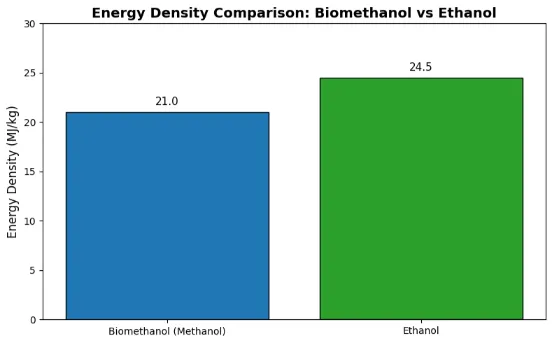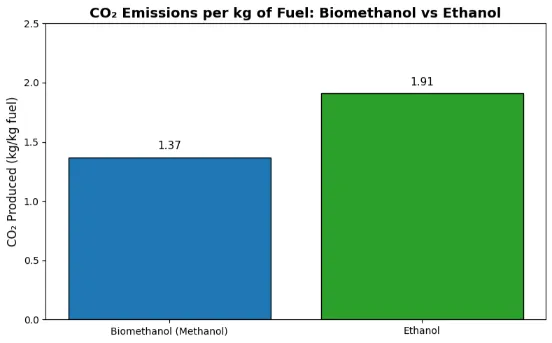
Biomethanol and Ethanol: Which Renewable Fuel Holds the Key to Our Future?
As the world moves away from fossil fuels, we need to find out which renewable fuels can truly offer a cleaner and more sustainable future. Biomethanol and ethanol are two of the main candidates often compared for their potential to reduce emissions in transport and power industries, while also helping countries achieve climate goals. So, which of these biofuels is better suited to lead us toward a low-carbon future? In this guide, we will look into the science, sustainability, economics, and real-world impacts of biomethanol and ethanol. This will help you understand which fuel could be vital for our energy transition.
What Are Biomethanol and Ethanol?
Biomethanol
Biomethanol is a renewable type of methanol made from biomass, including agricultural waste, municipal solid waste, or captured carbon dioxide. Unlike traditional methanol, which comes from natural gas, biomethanol offers a sustainable and low-carbon option that can be used as fuel, a hydrogen carrier, and a chemical feedstock.
Ethanol
Ethanol is an alcohol fuel mainly produced from plant materials like corn, sugarcane, and cellulosic materials. It is widely used as a gasoline additive or substitute, especially in the United States and Brazil. Ethanol is also a key part of many national renewable fuel plans.
Environmental Impact: Which Is Greener?
Biomethanol
- Greenhouse Gas Reduction: Biomethanol can cut greenhouse gas emissions by up to 90% compared to fossil-derived methanol.
- Feedstock Flexibility: It can be made from non-food biomass and waste, which helps avoid land-use changes and food security issues.
- Carbon Circularity: Advanced facilities are using carbon capture and utilization to make biomethanol with nearly zero carbon emissions.
Ethanol
- Lower Carbon Footprint: Ethanol has a much lower carbon footprint than gasoline and produces fewer pollutants when burned.
- Food vs. Fuel Debate: Most ethanol comes from food crops, which raises concerns about diverting resources from food production and increasing food prices.
- Land and Water Use: Ethanol production needs a lot of arable land and water, which can strain resources and affect biodiversity.
Production and Feedstock: Circularity vs. Competition
Biomethanol
- Feedstock: Uses agricultural residues, forestry waste, municipal solid waste, and captured CO₂, supporting a circular economy.
- Technology: Produced through gasification and fermentation, with ongoing improvements in efficiency and carbon capture methods.
- Scalability: Supply chains for feedstocks and conversion technologies are still being developed, but there’s strong potential for large-scale, sustainable production, particularly in areas with plenty of waste biomass.
Ethanol
- Feedstock: Mainly produced from food crops (corn, sugarcane), with some growth in cellulosic ethanol using crop residues and grasses.
- Technology: Established fermentation processes, but they are energy-intensive and sometimes use fossil fuels for processing.
- Scalability: Well-established in major markets, but growth is limited by land, water, and food security issues.
Energy Efficiency and Performance
Biomethanol
- Energy Density: Higher than ethanol but lower than gasoline, making it a good choice for blending and direct use in modified engines.
- Combustion: Provides cleaner combustion and reduces emissions of NOx and particulates, which is better for both vehicles and stationary power.
- Infrastructure: Can be mixed with gasoline or used in methanol fuel cells and is compatible with existing storage and distribution systems.
Ethanol
- Energy Density: Lower than both gasoline and methanol, which may reduce vehicle range unless engines are adjusted for ethanol.
- Combustion: Burns cleaner than gasoline but can increase evaporative emissions; engine compatibility may be a challenge for higher blends.
- Infrastructure: Commonly used as a gasoline additive (E10, E85), but high blends need engine modifications and specialized infrastructure.
Economic Factors: Cost, Investment, and Market Growth
Biomethanol
- Cost-Competitive: As technology improves and waste feedstock supply chains develop, biomethanol is becoming more cost-competitive with fossil fuels and other renewables.
- Market Growth: The global biomethanol market is expected to hit $9 billion by 2030, growing at a rate of 7% from 2023 to 2030.
- Investment: Attracting significant investments, particularly in Europe and Asia-Pacific, where policies support low-carbon fuels and rapidly growing infrastructure.
Ethanol
- Established Markets: Ethanol is already a multi-billion-dollar industry, especially in the US and Brazil.
- Subsidies and Mandates: Its growth has been driven by government mandates and subsidies, but the sector faces more scrutiny over sustainability and resource use.
- Price Volatility: Ethanol prices can fluctuate due to crop yields, weather changes, and commodity markets, leading to price uncertainty.
Applications: Where Do They Fit?
Biomethanol
- Transportation: Used as a direct fuel, mixed with gasoline, or as a hydrogen carrier for fuel cell vehicles.
- Industry: Serves as a feedstock for chemicals like formaldehyde and acetic acid, supporting greener manufacturing.
- Power Generation: Used in methanol fuel cells for clean electricity production.
- Marine and Aviation: Emerging as a low-carbon option for marine and aviation fuel, helping to decarbonize hard-to-reduce sectors.
Ethanol
- Transportation: Commonly used as a gasoline additive or substitute, particularly in flex-fuel vehicles.
- Industry: A feedstock for various chemicals, but less versatile compared to methanol derivatives.
- Rural Development: Supports rural economies and creates jobs in agricultural areas.
Challenges and Limitations
Biomethanol
- Feedstock Logistics: Large-scale production relies on reliable, sustainable supply chains, which are still not fully developed in many areas.
- Conversion Technology: Ongoing research is needed to improve conversion efficiency and lower costs.
- Policy Support: Needs strong policy frameworks and incentives to compete with established fossil fuels and ethanol subsidies.
Ethanol
- Food vs. Fuel: Dependence on food crops raises ethical and economic issues, especially in regions facing food insecurity.
- Land and Water Use: High resource needs can lead to deforestation, habitat loss, and water shortages.
- Engine Compatibility: High ethanol blends can cause engine wear and require infrastructure upgrades.
The Future Outlook: Which Fuel Holds the Key?
Biomethanol
Driven by innovation, policy support, and the demand for truly sustainable fuels, biomethanol is set for rapid growth. Its ability to use waste feedstocks, cut greenhouse gas emissions by up to 90%, and fit into existing infrastructures makes it a strong candidate for the future of renewable energy. As more countries and companies invest in circular economy solutions, biomethanol’s role is expected to grow in transport, industry, and power generation.
Ethanol
Ethanol will continue to be an important part of the renewable fuel mix, especially in regions with established production and infrastructure. However, its long-term growth may be limited by resource challenges and sustainability issues. Advances in cellulosic ethanol and integration with other biofuels could improve its environmental profile, but competition for land and water will remain a concern.
Conclusion: Biomethanol or Ethanol?
Both biomethanol and ethanol are crucial for the global energy transition, providing significant emissions reductions and supporting economic development. However, biomethanol’s adaptability, lower environmental impact, and fit with a circular economy make it a more promising option for a sustainable future. As technology improves and policies evolve, biomethanol is likely to become more central in decarbonizing transport, industry, and power—opening new pathways to a low-carbon world.

Related Reads on Biomethanol:
Explore how agricultural waste is being turned into clean fuel through innovative biomethanol production.
Discover how small businesses are saving money and going green with biomethanol solutions.

